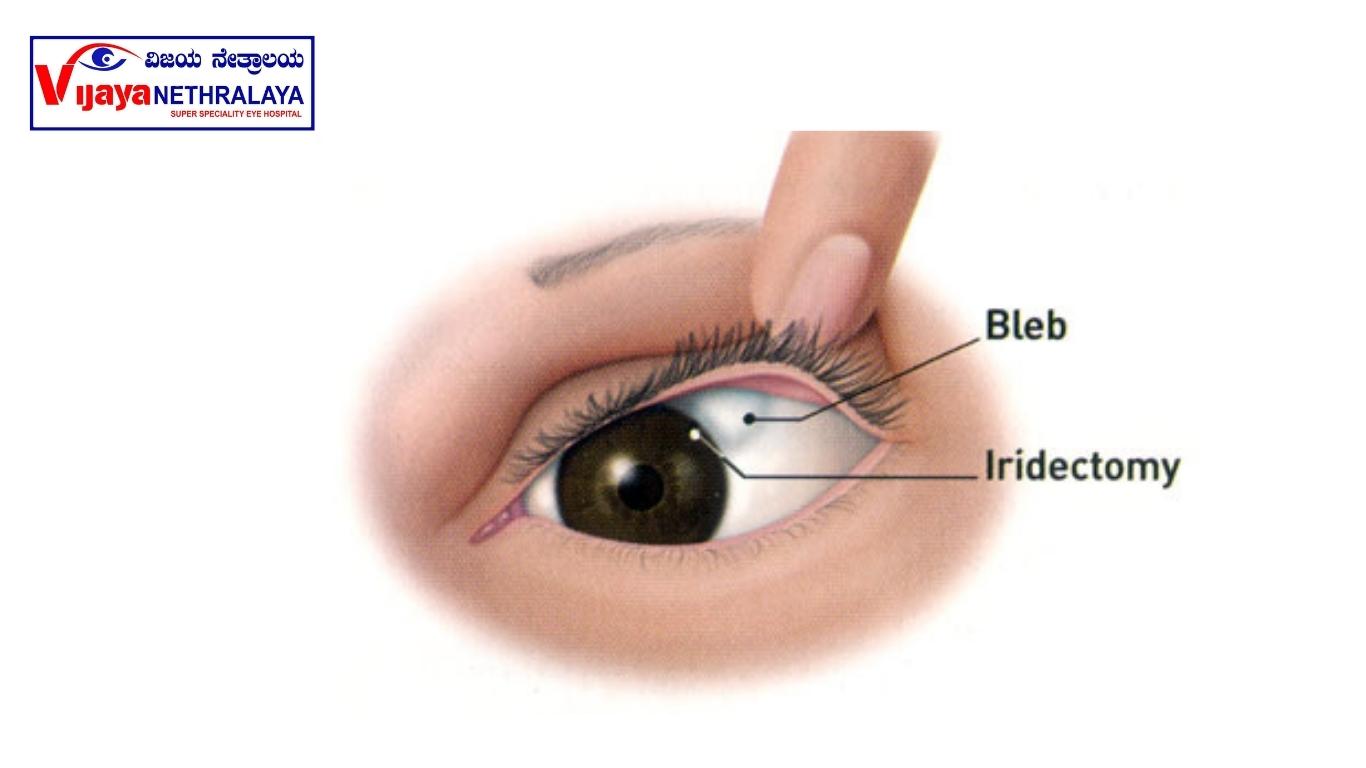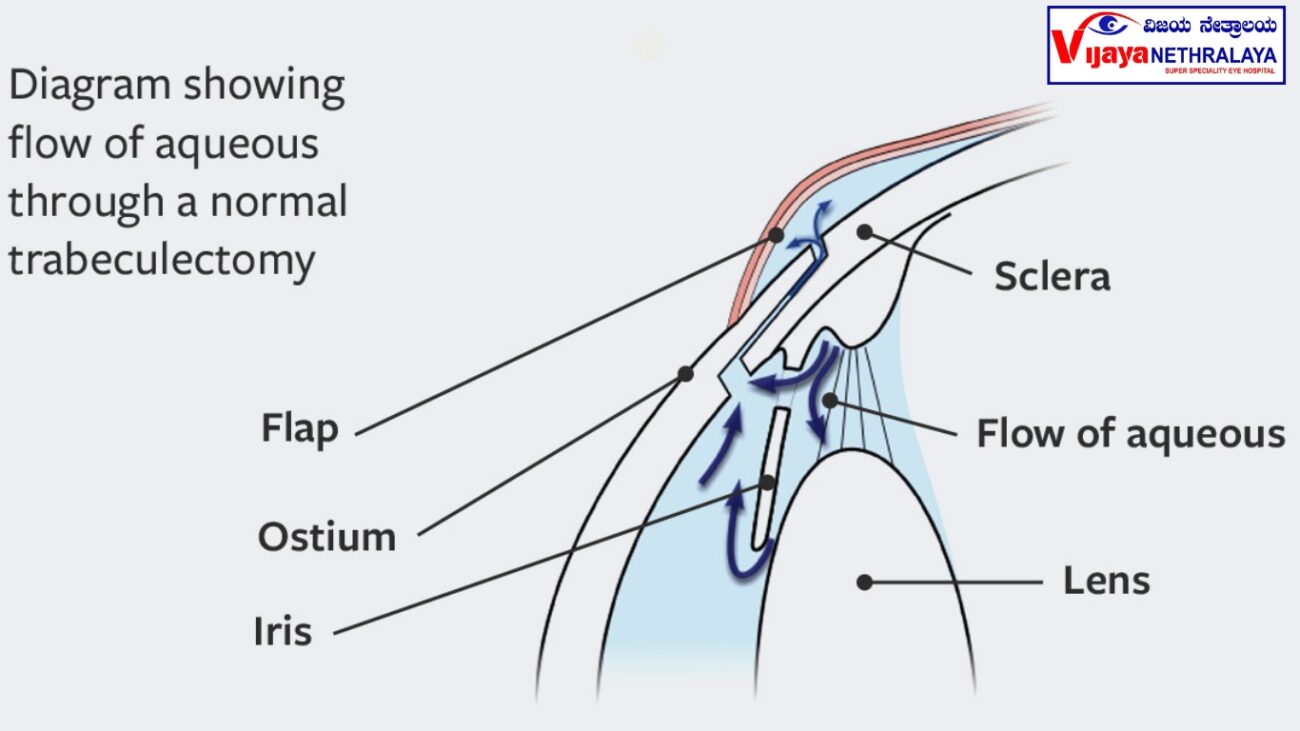Trabeculectomy: The Ultimate Guide to Treating Glaucoma
Understanding Trabeculectomy:
A trabeculectomy is a surgical procedure done in glaucoma to control or lower the intraocular pressure, which is unresponsive to anti-glaucoma eyedrops or laser therapy. Glaucoma occurs when the fluid in your eye is unable to drain normally, due to the blockage of the drainage pathway. This causes the intraocular pressure (IOP) to increase over time if left untreated causing damage to the optic nerve, resulting in visual field loss or blindness.
Trabeculectomy is done to create a new channel, thereby causing “bleb” formation externally on the top of the eye surface, through which fluid can drain from the eye. Bleb is nothing but a small blister containing fluid, that gets absorbed into blood vessels and does not cause excess tearing. Formation of bleb thereby restores the eye’s ability to drain fluid resulting in IOP lowering. The bleb is hidden by the upper eyelid and generally not noticeable by other people. This surgery can be done in any type of glaucoma, open angle or angle closure, or even secondary glaucoma.
Potential Risks and Complications of Trabeculectomy:
A trabeculectomy is a surgical procedure done in glaucoma to control or lower the intraocular
pressure, which is unresponsive to anti-glaucoma eyedrops or laser therapy. Glaucoma occurs
when the fluid in your eye is unable to drain normally, due to the blockage of the drainage
pathway. This causes the intraocular pressure (IOP) to increase over time if left untreated
causes damage to the optic nerve, resulting in visual field loss or blindness.
Trabeculectomy is done to create a new channel, thereby causing “bleb” formation externally
on the top of eye surface, through which fluid can drain from the eye. Bleb is nothing but a
small blister containing fluid, that gets absorbed into blood vessels and does not cause excess
tearing. Formation of bleb, thereby restores the eye’s ability to drain fluid resulting in IOP
lowering. The bleb is hidden by the upper eyelid and generally not noticeable by other people.
This surgery can be done in any type of glaucoma, open angle or angle closure or even
secondary glaucoma.
Trabeculectomy Recovery:
After surgery, immediate side effects include discomfort and blurry vision in the affected eye. The blurring may last for up to two weeks, but it can take up to 6 weeks for your eye to settle.
You may have to come for regular follow-ups in the postoperative period.
You will have to follow a routine of applying antibiotics and steroid eye drops for one to two months after surgery. Your surgeon will stop using your anti-glaucoma medications after surgery and may have to restart if IOP spikes.
You should avoid strenuous physical activity including sports, swimming, and high-impact exercise while you recover. Additionally, you should avoid any activities that require inversion, bowing, or bending, like sirsasana.
Depending on your job, you may also need to consult your doctor regarding when to resume your work. It is a good time to go to the office after 2 weeks but for manual labor, a longer time may be required before returning to work.
Postoperative outcomes can vary greatly from one individual to another, so the surgeon may have to guide you through your recovery process.
Protect the eye by avoiding eye rubbing.
Trabeculectomy Success Rate Explained:
Long-term, trabeculectomy has been proven to have a high success rate of around 70%.
Effective Glaucoma Treatment:
• The surgery will be done in the operating room, under either local or general anesthesia.
• Your eye will be numbed after receiving a local anesthesia injection.
• Your eye will be cleaned, draped, and opened with a lid speculum.
• During the surgery, your surgeon may gently rotate your eye and temporarily secure it in place using a stitch.
• Surgeon may have to inject or place mitomycin C sponges, an immunomodulator away from the surgical site to prevent complete healing of the fistula. This can help reduce scarring and the chance of the surgery failing in the long term. This is placed for a few minutes and then removed and washed vigorously.
• Your surgeon will create a flap on the sclera (the white part of the eye) underneath the upper eyelid. Underneath this flap, a fistula is created, which is nothing but seen as a small dark oval the flap allows fluid to drain out, and a piece of the iris is also removed.
•Afterward, the flap is carefully positioned back onto the sclera in a loose manner to provide protection for the drainage system.he Surgeon places sutures over the flap, to hold the “flap” in position, as the site must not reseal during the healing process. The entire surgery site is covered up using the conjunctiva (outermost covering of the eye). Your stitches will not dissolve and a few of them will need to be removed by your doctor within about two to three weeks.
• Surgery should last between 45 and 60 minutes. After the procedure, your eye will be patched and shielded. Your patch is removed on the next day, cleaned and the surgeon takes a look at the operated eye.
• This procedure can also be combined with cataract surgery.
Conclusion:
Trabeculectomy is a gold standard procedure done to control IOP and arrest the progression of glaucoma. Trabeculectomy does not restore vision that has already been lost. The purpose of the procedure is to prevent further loss of vision due to glaucoma. Success not only depends on the surgeon who handles the tissues meticulously, but also patients should remember that frequent postoperative follow-up is something very important that adds to the success of this procedure.


